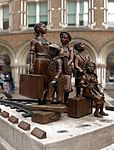Liverpool Street signal box
Grade II listed buildings in the City of LondonMetropolitan RailwayRail transport in LondonSignal boxes in the United KingdomUse British English from January 2017

The Liverpool Street signal box is a Grade II listed disused signal box at Liverpool Street tube station in London. It was opened for operation in 1875 for an extension of the Metropolitan Railway. It was converted to an interlocking machine room in the 1950s. In 2013 it became the third signal box on the London Underground network to be listed.
Excerpt from the Wikipedia article Liverpool Street signal box (License: CC BY-SA 3.0, Authors, Images).Liverpool Street signal box
Liverpool Street, City of London
Geographical coordinates (GPS) Address Phone number Website Nearby Places Show on map
Geographical coordinates (GPS)
| Latitude | Longitude |
|---|---|
| N 51.517611111111 ° | E -0.08305 ° |
Address
The Merchant of Bishopsgate
Liverpool Street
EC2M 7PY City of London
England, United Kingdom
Open on Google Maps










